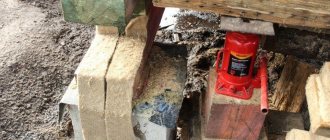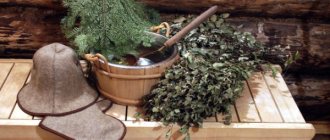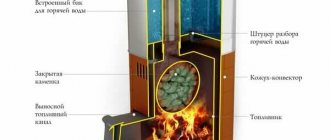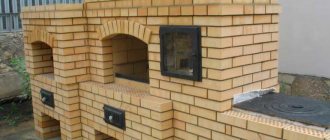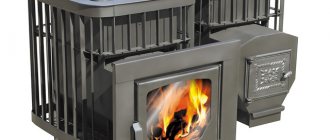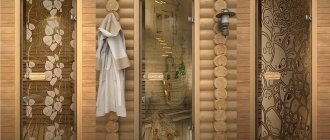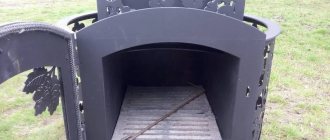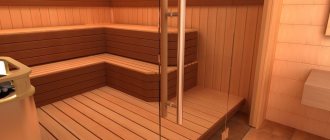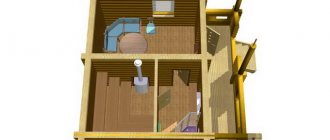After purchasing a stove, some of our clients make a firm decision to install it themselves. We support such initiatives and, whenever possible, help with consultations, because if a person has the time and desire to do something with his own hands, that’s always wonderful. We treat cases with less confidence when clients entrust the installation of a furnace to cheap builders and installers...
The critical difference between these two cases is that the owner will always double-check several times in Yandex: “how to properly install a stove for a bath.” But one-time specialists more often rely on their logic than on SNiP standards - after all, studying the standards is not included in the cost of their work. In this article we will tell you exactly what needs to be checked and taken into account if the installation of the furnace is carried out independently or through dubious specialists.
Why did we decide to write this article? The fact is that about 3 years ago, the government of our country decided that installers of stoves and fireplaces are no longer required to license their activities (Resolution No. 1219 of October 6, 2017).
This means that it’s enough to make a website, fill it with water about your mega-experience, set the price 2-3 times lower than competitors and order advertising. As a result, clients, tempted by the low price, hire such unfortunate masters, after which they find themselves in extremely bad situations. Moreover, the easiest of them is the need to purchase a new stove. But there are worse consequences. You can learn about such “worse” from fire department reports: “The installation was carried out in violation of the standards...”
We recommend not to chase the lowest cost in this matter and either trust professionals, or delve into it and figure it out yourself. It was for the second client case that we decided to prepare a series of articles. This is how this article appeared.
The first piece of advice from our experts is:
If you want to save money on installing a stove for your bathhouse, then understand the basics and supervise the work of hired workers.
If you don’t want to control it, then delve into the issue entirely and install the stove yourself.
If you don’t want to get involved, then leave the issue to a specialized company.
So, you have already built a sauna with a steam room, chosen and bought a stove, and even stocked up on oak brooms. It’s just a matter of little things, well, almost - all that remains is to install the stove and you can enjoy the healing properties of a real Russian wood-fired bathhouse. But to prevent your long-awaited dream from turning into a nightmare, consider the following...
What to install a sauna stove on
A sauna stove, like no other, requires installation on a non-flammable base, because its combustion center is practically on the floor. This means that the temperature load on the floor is greater. We recommend that you use only one of the four base options listed below for sauna stoves.
A metal sheet
Most often, stainless steel or galvanized sheets are used, but painted flood sheets look more beautiful. They come in different sizes, shapes and colors. The options are presented here.
Thermal insulation must be laid under the metal sheet, because... it conducts heat very well. Ordinary basalt cardboard will do, but it is better to additionally use a fiber cement board: faspan, mineralite or flamma.
Agglomerate tiles
This is a tile made from pressed granite chips. Due to the dense structure, the weight of one tile measures 600x600 mm. is 20 kg. As a rule, several pieces are used for the agglomerate base, which are laid on a sheet of CBPB or the same fiber cement board. It is also necessary to use basalt cardboard.
Fig. 1. Base for a sauna stove made of agglomerate tiles
Installation on ordinary porcelain tiles is allowed - the base design will be the same as with agglomerate tiles. But porcelain stoneware is thinner and more fragile, it can burst under the weight of the stove, especially with stones.
Bricks
Installing a sauna stove on bricks is only possible on a flat floor. If a sheet of metal and agglomerate tiles allow for slight unevenness, then the bricks will not “forgive” them - they will move higher and lower. In this case, you will need to level the floor first. If the bricks are laid on a concrete floor, then no thermal protection is required, but if on a wooden floor, then the above-mentioned basalt cardboard can be used.
Fig 2. Grill'D Cometa 180 Vega sauna stove mounted on bricks
Ready bases
Some manufacturers of sauna stoves produce special podiums on which they recommend installing their products. Such podiums, as a rule, do not require additional thermal protection, because have convection channels that cool the floor underneath.
But we consider it not unnecessary to use additional thermal protection under ready-made substrates.
Thermal insulation materials are presented in our section of the website here.
Fig 3. Vesuvius Legend sauna stove installed on the “original” metal base
Traditions and recommendations
Despite the lack of a uniform standard, there are traditional ways to determine ceiling height. Typically, a Russian bathhouse was built individually, for the family living in the house. Therefore, to determine the required parameter, the tallest member of the family stood on the floor and raised a broom upward.
The tip of the bunch of branches in the outstretched hand was the boundary on which the ceiling was built. In modern conditions, such a building can be used for commercial purposes or for recreation with friends and colleagues.
The method of determining the height dimension has become less common, so experts prefer to recommend when building a bathhouse a height in the range from 2.1 meters (but not less, otherwise the steamer will be uncomfortable) to 2.40 m.
These are the parameters that are considered optimal:
- the steam room warms up quickly enough, and the consumption of firewood does not exceed the normal amount;
- with a height of up to 2.4 m, even an electric oven does not require a lot of electricity consumption to properly warm up the workspace;
- if there is a tall person in the family, you can use his arm extended upward as a standard - this will ensure that those taking a steam bath will not experience discomfort in any position;
- sometimes you can find advice to add half a meter from the tip of the middle finger of an outstretched hand, but if the height is greater than 5 m, then more fuel will be required and the steam will go to the ceiling;
- 200 cm will already lead to the accumulation of steam almost at the level of the respiratory organs, in such an atmosphere it will be difficult to breathe;
- in a compact structure, a ceiling of 20 m is sufficient, but if a structure is being built for commercial use, with a large number of visitors and steam volumes, the ceiling should be at least 3 m.
Experts say that the construction of a bathhouse should certainly begin with agreeing on the size of the steam room. In this case, all dimensions are proportional to the calculated number of visitors. The ceiling height can be 220 cm or 230.
The sauna can be 210 cm high, but not more than 240 centimeters. Heating in it takes place according to a different principle, and the distance from the floor can significantly increase fuel consumption. You can determine how to optimally arrange the shelves by knowing the design features.
There are several varieties, which need to be arranged according to a pre-selected pattern. The subject of preference can only be the modification that ideally fits the dimensions of the room.
Safe distance from the stove to the flammable wall
A stove is, first of all, a fire, which means there are regulated standards for its installation and operation for fire safety.
The current rules (SNiP dated April 2, 05-91) state the following: The safe distance from the stove to the flammable wall (including wooden shelves) must be at least 500 mm.*
*Appendix 16 (mandatory). Dimensions of grooves and offsets for stoves and smoke ducts.
How to reduce the distance from the stove to the wooden wall and comply with safety standards?
In practice, the distance is 500 mm. You can't always stand it. You will not rebuild the bathhouse. Fortunately, progress is moving forward every day, and modern thermal insulation materials are appearing on the market, which provide much greater protection than those provided for in SNiP itself. Using such materials, the distance can be reduced to 250 mm. We will talk about them below.
How to check the standards in an accessible way?
To make sure that you have maintained a fire-safe distance, test the wall with your hand. If installed correctly, the wall should be warm at the level of the stove.
Of course, the question of the safe distance from the stove to the flammable wall may be a little late if, during the construction of your bathhouse, you did not particularly compare the dimensions of the future stove with the area allocated for it. And if you still made a slight mistake in this matter, now it will be difficult to cram in what you can’t fit in. In any case, we do not recommend compromising your conscience. Call us and we will advise you on what can be done in your specific situation.
Video on how NOT to install a sauna stove
Please note that incorrect installation consists not only of errors in the distance from the furnace to nearby objects, but also of errors in the installation of electrical wiring, its operation, incorrect arrangement of chimney passages through the ceiling, etc. - all this can cause a future fire, but we will talk about this in the following articles.
Features of installation in wooden buildings
When installing a stove in a panel house, cobblestones or logs, you must adhere to the following SNiP standards:
- there should not be less than half a meter of free space from the back of the stove to the wall;
- the minimum distance from the top edge of the stove to the ceiling is 1.2 m;
- there must be at least 1.30 m of free space in front of the furnace door;
- The minimum width of sheet material in front of the firebox is 50 cm, length is 70 cm.
If the walls are finished with plaster, installation and installation of a cast iron stove in a wooden house can be done at a distance of 0.4 m from them.
Determination of optimal parameters
When designing vaping devices, it is necessary to find a consensus between standardized requirements and the presence of individual characteristics of family members or regular visitors.
The comfort of staying in the bathhouse depends on pre-calibrated meters and centimeters. This data is also important when purchasing building materials.
Therefore, it is necessary to decide what the distance of the shelves in the bathhouse should be at the design stage.
To do this, it is recommended to first measure the expected space, and then choose the configuration and depth of the shelves that you like or that is optimal for the room. The parameters should be correlated with the requirements of convenience and comfort of those who will be here for the purpose of washing or healing.
When taking measurements, take into account the following:
- the length of the shelf can vary from 1.8 to 2 m - the latter parameter will allow you to receive guests of almost any height, and saving on length will make the lying position uncomfortable for a tall person;
- you can limit yourself to 1.5 m, but on such a step you can only lie with half-bent legs or in a fetal position, which makes it doubtful to get real pleasure from the steam room;
- the minimum for the bottom shelf is 40 cm, usually it is used as a footrest, but this width allows a beginner or someone who does not perceive heat well to sit with sufficient comfort;
- the middle and top ones are usually made at least 60 cm, in such a space you can sit in different positions for quite a long time.
It is also worth noting:
- if the shelves are 90 cm wide, it is convenient to take a lying position on them both on your back and on your stomach;
- the height calculation begins not from the bottom, but from the top shelf, while the main reference point in a Russian bath is the steam door of the stove, but the bottom bench should not be lower than 30 cm from the floor;
- the fastening of vertical supports should be at least 60 cm so that the structure does not sag even with significant weight of the person lying or sitting, although it may vary slightly depending on the thickness of the wood used;
- the height of the top shelf should be measured from the ceiling above - at least a meter is left from the head of the person sitting on the top bench to the ceiling, so it is important how much the height of the bathhouse is.
Nuances of height
The dimensions of the shelves in the sauna may differ from the parameters recommended for the Russian steam room. It is enough to compare the method of heating air and the conventional vaping method to be convinced of this.
In the Finnish one, people sit more often than lie down, and the distance from the shelf to the ceiling and the width of the lounger are not so important. The shelf can rise from the floor to a height of 140–150 cm. In addition, the sauna can be built smaller in height and in other dimensions. The air in it heats up much faster.
Layout and height
The height of the shelf in the bathhouse from the floor depends on the chosen variety. Typically, the shelving is placed along one wall - either the one without windows, or located on the side of the door.
This is necessary so that the cold air from it when leaving and entering does not destroy the atmosphere for those who are in the steam room. The choice of option undoubtedly depends on the owner. But before making a decision, it is better to listen to the authoritative opinion of a specialist in order to make the height of the shelves correctly.
- The linear design is the simplest and is the standard design used most frequently. It is installed under one wall and represents a kind of steps with gradually increasing degrees and consistency of steam. Each shelf is designed for a more resilient visitor. The steam room can have two or three tiers; the height of the bottom shelf is recommended to be at least 50–60 cm.
- In total, the shelves should not be higher than 2 m, but this height can only be made in a high room. It is believed that a seat with a height of less than 60 cm is uncomfortable not only for the person sitting on it, but also for the steamer with a broom. He will not be able to work at full capacity.
- The height of the shelves in the steam room of any Russian bath varies from 30–35 cm to 60. But the lower limit is acceptable only for low buildings. Making them too low means causing inconvenience to both your guests and yourself.
- A completely workable arrangement option is in the form of the letter G. It is arranged in the corner, between adjacent walls - in the form of one shelf, which must be hung on both walls, at a height of no more than 60 cm. It can be two- or three-stage. There is an option for arranging the upper and lower shelves near one wall, and the middle one against the other.
